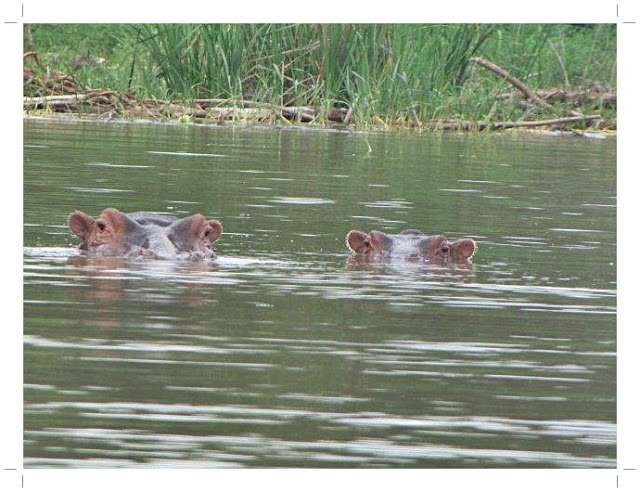As Johnson steered the boat around another corner of the island, he cut the engine and the boat drifted towards a shallow area amongst the reeds. This was the home of the resident hippo family on this side of the lake and we weren't disappointed. There were two ears and eyes peering at us with the hump of another hippo visible just beyond it.
Then another head appeared and watched us on the boat not even two meters away
Riddle: What's worse than two hippos in the water near your boat?
Answer: One hippo! You don't know where the other one is; under your boat perhaps? The lazy look in the eye belies the speed with which this animal can move underwater to get to you. They're incredibly fast on land too and easily outrun a human
*The hippopotamus (Hippopotamus amphibius), or hippo, from the ancient Greek for "river horse" is a large, mostly herbivorous mammal in sub-Saharan Africa, and one of only two extant species in the family Hippopotamidae (the other is the Pygmy Hippopotamus.) After the elephant, the hippotamus is the largest land mammal and the heaviest extant artiodactyl, (even-toed herbivorous mammal) despite being considerably shorter than the giraffe.
The hippopotamus is semi-aquatic, inhabiting rivers, lakes and mangrove swamps where territorial bulls preside over a stretch of river and groups of five to 30 females and their young. During the day they remain cool by staying in the water or mud; reproduction and childbirth both occur in water. They emerge at dusk to graze on grass. While hippopotamuses rest near each other in the water, grazing is a solitary activity and hippos are not territorial on land.
There are an estimated 125,000 to 150,000 hippos throughout Sub-Saharan Africa; Zambia (40,000) and Tanzania (20,000–30,000) possess the largest populations. They are still threatened by habitat loss and poaching for their meat and ivory canine teeth.
Despite its stocky shape and short legs, the hippo can easily outrun a human. Hippos have been clocked at 30 km/h (19 mph) over short distances. The hippopotamus is one of the most aggressive creatures in the world and is often regarded as one of the most dangerous animals in Africa. *
* Source: Internet/Photos: All mine
After we'd all taken photos, Johnson started the motor and eased the boat away from the hippo family. A few meters along we came across two young boys in shallow boats using their hands or flattened plastic bottles to paddle their craft. They pulled up alongside our boat to show us their catch.
Not far from the hippos, we saw these two lads fishing from shallow boats
The young fishermen told us the fish were called Mudfish. Unfortunately we didn't have our wallets with us else I'd have asked Grant to buy a fish and return it to them
Unbeknown to me, while I was taking the photo of the fish, Sue took a photo of me, with Grant leaning forward and Johan watching with great amusement!
At 9am, Johnson beached at the jetty and we were still in time for a scrumptious breakfast in the restaurant overlooking the lake.
The thatched, open-sided restaurant overlooks several accommodation tents and the lake
As usual the weaver joined us for breakfast
After breakfast we collected our luggage and went down to the jetty to wait for our boat. Of course, Sue, Ruth and I wandered around trying to spot more birds. My favourite was a capture of a Spotted Palm Thrush sitting on its nest.
Spotted PalmThrush sitting on its nest in an acacia tree near the jetty
One last photo of Island Camp
And just when we thought it was safe to go back into the water, Ruth spotted a crocodile near the boat.
We reached the mainland just before midday on Sunday. This was not the end of our wonderful weekend. We stopped at Lake Baringo Club for lunch and more incredible birding and hippo spotting. (to be continued)















Neat photos of the hippo's, Jo. I had no idea they could outrun a human... Sounds like you had a wonderful time.
ReplyDeleteHugs,
Betsy
thank you for nice sharing
ReplyDeleteWonderful, Jo. Love your photos and your adventure stories.
ReplyDeleteWe're in St. Petersburg, Russia now. I'm sending Dick on the Hermitage tour by himself as it is 5 hours and I'm not feeling up to it, but I know he'll get plenty of fabulous photos.
Take care.
Luv, K
Grand photos of your trip. I want to bring my rod and reel and go fishing! You got great pictures of the hippo and the croc!
ReplyDeleteThe fish the boy is holding is definitely one of the mud fish species. In spite of their name make good eating. Either Purple Labeo, reddish scales,(Labeo congoro), or the Redeye Labeo (Labeo cylindricus). Both occure widely in East Africa. Paul Skeltons book, "Fresh Water Fishes of Southern Africa."
ReplyDeleteI am feeling so envious of you all right now! What a fabulous weekend amidst such beauty! I also enjoyed reading Phillip's enlightening comment :)
ReplyDelete